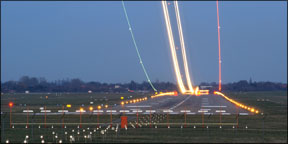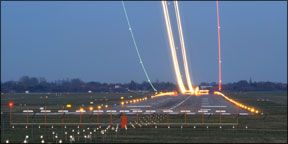Its morbidly fascinating to look at landing accidents involving pilots who came to grief while shooting an ILS in instrument weather. By contrast, VFR landing accidents tend to involve loss of control after landing, usually a result of too much speed at touchdown. Few VFR landing accidents involve crashing short of the runway itself. Yet, when actual IFR weather moves in and the airplane is on the ILS, the converse occurs, and suddenly pilots develop a proclivity for crashing

288
before ever getting to the runway. As would be expected because an airplane is going far faster prior to the time it touches down than when it is when rolling out, landing accidents when flying the ILS in IFR conditions are more often fatal than landing accidents when flying VFR.
The instrument landing system has been around for over a half century. In its own way, it is instrument flyings simple and reliable old boot; the two-needle, three-dimensional approach system that funnels one to a touchdown spot about 1500 feet down a comfortingly long runway. With a time-proven design that guides arriving aircraft over the runway threshold at a safe 50 feet or so, how come so many GA pilots find a way to depart from the friendly confines of the ILS arrival cone and smack into the planet before getting to the runway? Why are so very few GA ILS accidents in IFR of the sort where the airplane overshot the touchdown point and went off the end of the runway as is expected in VFR conditions?
Sight Picture
Beyond the few pilots who have made the odd, and often fatal, decision to simply fly below the glideslope, the all too common answer to the question is a habit pattern that has been ingrained during good weather training and practice. The pilot comes down the ILS at an appropriate speed, somewhere around 100 to 120 KIAS. The instructor calls runway in sight at DA, about 200 feet above the ground and a nearly a half mile from the end of the runway. The pilot, who has pretty much nailed the descent rate and power required to hold the glideslope, the heading needed to keep the localizer needle inside the instrument and has the airplane pretty well stabilized, promptly raises the hood or takes off the Foggles, spots the runway and goes into feverish action to slow the airplane down to landing approach speed, make the turns needed to get positioned for the runway centerline, drop more flap and aim for the end of the runway while completely ignoring the localizer and glideslope needles that had been, until then, the primary objects of the pilots world.
In short, once the runway can be seen, the pilot takes action to create the visual picture that he or she has been looking at for dozens of hours of VFR landings. Of course, the glideslope slowly disappears in an upward direction and the pilot lands the airplane pretty much as she or he would on a beautiful VFR day (which it just happens to be). Touchdown is about 400 feet beyond the threshold and everyone seems quite happy, almost as if there were a prize awarded for the shortest landing out of an ILS.
Habit Patterns
Lather. Rinse. Repeat. The pilot, now instrument-rated, has, in VFR conditions developed a habit pattern that may very well kill him or her when the visibility and ceiling are down: pulling the power back upon seeing the runway, well before getting to it, and disregarding the ILS needles while simultaneously making big power and speed changes and maneuvering to line up with the runway, at low altitude, short of the runway threshold.
During instrument training and practice after the rating, a pilot almost never gets much experience making a landing in conditions of reduced visibility and low ceilings. That means a pilot flying his or her first few dozen ILS approaches in for-real weather is facing something without having had training or practice: Making big power and speed changes, and maneuvering to line up, when short of a runway in crummy weather. Humans do not have a good record when it comes to successfully carrying out a complex series of actions for which they have not been trained or havent recently practiced.
In the Real World
So lets consider weather with the VFR training habit pattern. Real IFR weather. The kind where you have to shoot the ILS and getting in is a maybe so, maybe not proposition. Perhaps there is some ice in those clouds on the approach. Maybe its raining and the falling rain is cooling the air, causing clouds to start to form near the ground.
Our pilot shoots the ILS and spots the runway at or somewhat above DA. Habit pattern intact, the power starts coming back and the airplane starts descending below the glideslope as the pilot does a bit of an “S” turn to line up with the center line while making the usual play for a touchdown spot just past the threshold. At 100 feet, and still well short of the runway end and slowed to nearly 1.3 VSO, with landing flaps selected, the airplane enters one of those low-lying clouds that it would have gone over had the pilot stayed on the glideslope. Its missed-approach time. Our hero has to get back on the gauges, bring the power up, pitch up, clean up the airplane and try to establish a climb. Oops, impact, usually more or less wings level, on the rough ground or in the trees or approach lights, short of the runway.
Lets say there is some ice on the airplane. Our pilot knows enough to leave the flaps up when landing in ice, having read the POH and seen the NASA videos on how flap deflection can lead to tailplane stall. However, the habit of slowing down and aiming for the threshold once the runway is in sight is so ingrained that a power reduction is made once the runway is spotted. The ice-redesigned wing stalls-impact short of the runway.
The other interesting little adventure is the daytime ILS approach in snow and a strong crosswind. When the white-on-white runway environment swims into view in the half-mile-or-so visibility and flat light, the approach lighting system may or may not be of much assistance in lining up with the runway and taxiway lights, if on, are nearly impossible to spot. The reality is a two-dimensional world of white with two more-or-less snow-covered, parallel strips of concrete. With the crosswind correction necessary to stay on the localizer, the airplane may be pointed at the taxiway. There isnt much time to sort out which is the runway, and the pilot who has gotten into the habit of disregarding those steady needles that got him very near to success may land on what is directly in front of the nose. So long as there isnt another airplane on the taxiway, such a landing is usually only embarrassing, but having another machine suddenly materialize out of the snow, directly ahead, while touching down, is said to be less than fun.
In the real world there are rarely simple answers to the problems we face. Fortunately, this isnt one of those times. When it comes to avoiding a stop amid the approach lighting stanchions after finding out that “frangible” means theyll break but they arent soft, there is a simple, two-step procedure that works and should become a habit pattern. It consists of flying the approach at a safe speed, 100-120 KIAS for most piston singles and twins and then not messing with what has been working until crossing the runway threshold on glideslope.
Hold What Youve Got
No matter when you break out of the clouds on the ILS, hold the power setting and heading and keep cross-checking the needles even though you can see the runway. Its much easier to make the turns to line up with the centerline, referencing the localizer needle, while you are holding a constant speed and descent rate rather than while those two variables are also changing. While its rare, things do go wrong from time to time, usually when you least want them to, so you may have to miss the approach after you have the runway in sight. You may suddenly pop back into clouds (especially at night) or someone may pull onto the runway. So, hold the speed and stay on the glideslope until the risk of having to miss the approach drops as low as possible.
On glideslope, you will cross the runway threshold at about 50 feet agl. You have assured yourself of making the runway and eliminated the high-risk/high-speed crash short of the runway, so you have done nothing but good things for yourself. Once at the runway threshold you are low enough that you probably wont go back into the clouds, and if you do have to attempt a missed approach and cant quite pull it off, youll probably touch down on the runway itself, which is the best place for an inadvertent return to earth.
On the approach, youve been carrying a fairly low power setting, something below cruise, so the engine has been cooling gently for the last few minutes. As a result, smoothly bringing the power to idle as you cross the threshold is not going to shock cool the engine (even assuming shock cooling exists). You trim to slow the airplane and, once in the white arc, drop all the flaps to help decelerate to 1.3 VSO while continuing to descend.
But what about getting down and stopped with all that speed at 50 feet over the threshold? Think about it a moment. The airliners, flying that ILS into the same runway, cross the threshold at that same 50 feet; theyre going much faster than our 100-120 KIAS and they have no problem getting down and stopped. For a DA40 or Cessna 172, getting down and stopped from 50 feet at 1.3 VSO takes about 2000 feet. Crossing the threshold at 120 KIAS and closing the throttle, dropping flaps and slowing to 1.3 VSO takes about 1000 feet, so youll still be down and stopped by the 3000-foot point on the runway, hardly an overrun risk as most ILS-equipped runways are at least 5000 feet long.
The benefit to holding what youve got for speed and flying the needles all the way to the threshold every time you practice an ILS, no matter what the weather, is that it builds a habit pattern that may very well keep you alive when it really matters. The fact that you havent already started futzing around with the power and flaps and speed means that you can smoothly pitch up to climb attitude, firewall the throttle and are on your way to a safe altitude with a major league initial rate of climb and airspeed well in hand. When the airplane is encased in ice and you in sweat, your habit pattern of holding what youve got may prevent you from making a sudden power reduction and stalling at 180 feet agl, and when you emerge from the snow squall in the strong crosswind, youll hold the heading you have and follow the localizer to the runway, rather than the taxiway.
When the clouds part and the runway appears, it is not a cusp event requiring frantic action on your part. It is just another data point in the event that is an ILS approach. It is not the time for changing anything, just a time to tell yourself that it looks as if youll be able to land, if you leave things as they are for a few more seconds, until you see that runway threshold pass safely beneath you.
Rick Durden is a practicing aviation attorney and type-rated ATP/CFI with more than 7000 hours.




